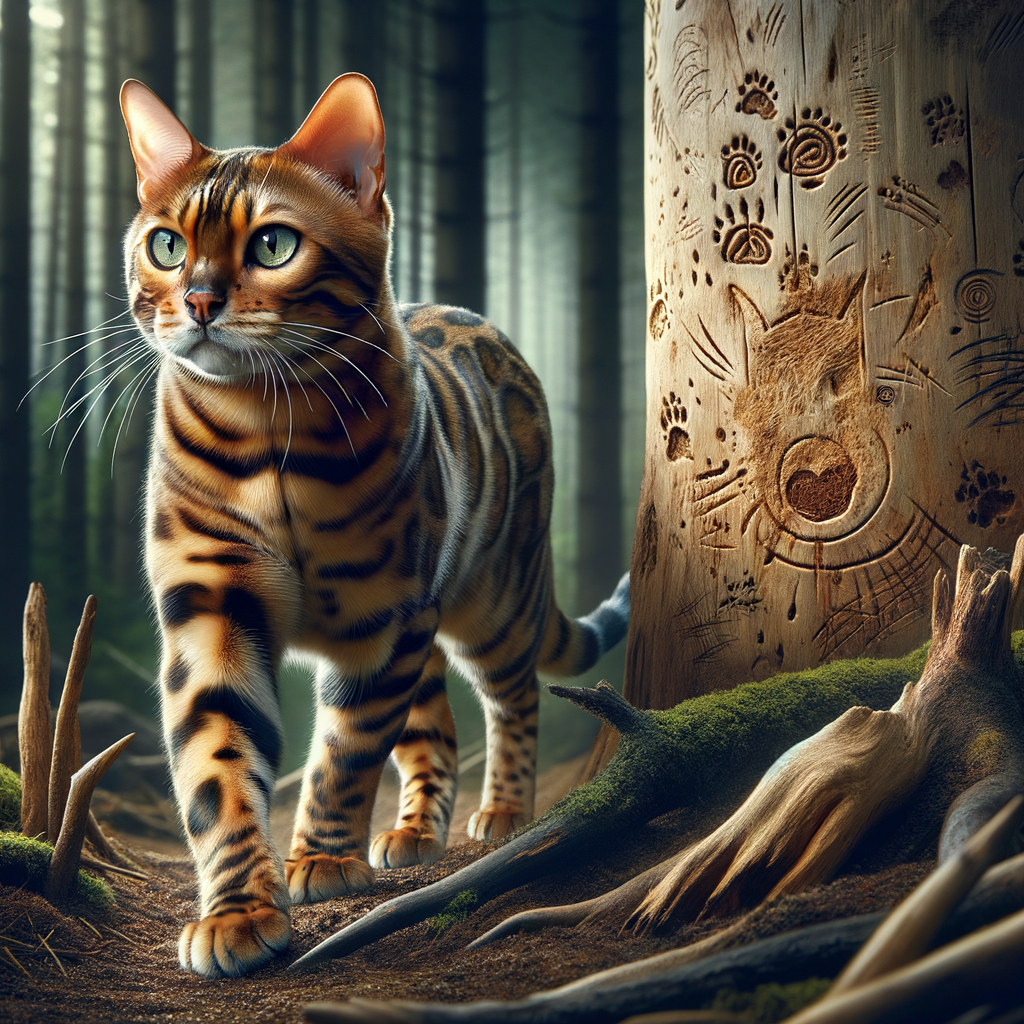
Introduction to Bengal Cat Behavior
- The unique traits of Bengal cats: Bengal cats are known for their wild appearance and energetic behavior. They are a hybrid breed, created by crossing domestic cats with Asian leopard cats. This gives them a distinctive look and unique personality traits. Bengals are highly active, curious, and intelligent. They love to climb, play, and explore their surroundings.
- Importance of studying Bengal cat behavior: Understanding their needs helps owners provide a better environment for them. It also helps in addressing any behavioral issues that may arise. By studying their behavior, we can ensure that Bengal cats live happy and healthy lives.
Bengal Cat Territory
Defining Bengal Cat Territory
- What constitutes a Bengal cat’s territory?A Bengal cat’s territory includes areas where they eat, sleep, and play. It can be inside your home or in your yard. They mark these areas to feel safe and secure.
For example, a Bengal cat might consider your living room, kitchen, and backyard as part of its territory.
- How Bengal cats establish their territoryBengal cats establish their territory by marking it with their scent. They do this by rubbing their face or body against objects. This leaves a scent that tells other cats, “This is my space.”
Another way they mark territory is by scratching. Scratching leaves both a visual mark and a scent mark from glands in their paws. This helps them feel more at home.
Bengal Cat Home Range
- Difference between territory and home range:A Bengal cat’s territory is the area they defend from other cats. It includes places where they eat, sleep, and play. The home range is larger. It includes the territory and areas they explore but don’t defend.
- Factors influencing the size of a Bengal cat’s home range:
- Food Availability: If food is scarce, cats roam further to find it.
- Population Density: In areas with many cats, home ranges are smaller.
- Gender: Male Bengal cats usually have larger home ranges than females.
- Age: Younger cats tend to explore more, expanding their home range.
- Environment: Urban cats have smaller home ranges compared to rural ones.
Bengal Cat Aggression and Dominance
Bengal Cat Aggression
- Common signs of aggression in Bengal cats
- Hissing: A clear sign that your cat is upset.
- Swatting: Using their paws to hit.
- Growling: A low, rumbling sound.
- Staring: Intense eye contact.
- Flattened ears: Ears laid back against the head.
- How territoriality influences Bengal cat aggressionBengal cats are very territorial. This means they like to have their own space. When another cat or animal enters their territory, they might become aggressive. Here are some ways territoriality can influence their behavior:
- Marking territory: Bengals may mark their area with urine or scratching.
- Defending space: They may become aggressive to protect their space.
- Resource guarding: They might guard food, toys, or sleeping areas.
Bengal Cat Dominance
- Role of dominance in Bengal cat social structureDominance plays a key role in the social structure of Bengal cats. In a group, one cat usually becomes the leader. This leader cat makes decisions and controls resources like food and resting spots. This helps keep order among the cats.
For example, a dominant Bengal cat may eat first or choose the best sleeping area. Other cats in the group will follow the leader’s actions. This behavior is similar to how wild cats live in nature.
- How dominance affects Bengal cat interactionDominance affects how Bengal cats interact with each other. A dominant cat may show its status through body language. This can include standing tall, staring, or even hissing. These actions let other cats know who is in charge.
In homes with multiple Bengal cats, you might see the dominant cat grooming others. This is a way to show care but also to reinforce its position.
Bengal Cat Marking
Why Do Bengal Cats Mark Their Territory?
- The purpose of marking:Bengal cats mark their territory to communicate with other cats. This behavior helps them establish boundaries and reduce conflicts. By marking, they signal their presence and claim ownership of a space.
- Common methods of marking in Bengal cats:
- Spraying: Spraying is when a cat releases a small amount of urine on vertical surfaces. This is a common way for Bengal cats to mark their territory.
- Scratching: Bengal cats scratch objects to leave visual and scent marks. Their paws have scent glands that release pheromones when they scratch.
- Rubbing: Bengal cats rub their faces and bodies against objects. This transfers their scent from glands located around their face and body to the object.
Dealing with Bengal Cat Marking
-
Practical Tips for Managing Marking Behavior
- Clean Marked Areas: Use enzymatic cleaners to remove the scent from marked spots. This helps prevent re-marking.
- Provide More Litter Boxes: Ensure you have enough litter boxes. The rule of thumb is one box per cat, plus one extra.
- Reduce Stress: Stress can cause marking. Provide a calm environment and plenty of hiding spots.
- Spay or Neuter: Spaying or neutering your Bengal cat can reduce marking behavior significantly.
- Use Feline Pheromones: Products like Feliway can help calm your cat and reduce marking.
-
When to Seek Professional Help
- Persistent Marking: If marking continues for more than a few weeks.
- Health Issues: If you suspect a medical problem, consult your vet.
- Behavioral Problems: A professional animal behaviorist can provide tailored advice and solutions.
Bengal Cat Social Structure
Bengal Cat Social Hierarchy
- How Bengal cats establish social orderBengal cats establish social order through a mix of behavior and communication. They use body language, vocalizations, and scent marking to show dominance or submission. For example, a dominant Bengal may puff up its fur and hiss to show authority. Submissive cats often lower their heads and avoid direct eye contact.
Studies show that Bengal cats, like many other animals, have a clear social hierarchy. This helps reduce conflicts and ensures that each cat knows its place in the group.
- The role of territory in Bengal cat social structureTerritory plays a big role in how Bengal cats interact. Each cat has its own space, which it marks with scent glands located on its face, paws, and tail. This marking helps other cats know which areas are already claimed.
When a new Bengal cat enters a territory, it must navigate the established social structure. This can lead to initial conflicts, but over time, the new cat will find its place in the hierarchy. Proper introduction and enough space can help ease this process.
Aspect Details Social Order Established through behavior and communication Territory Marked with scent to show ownership Conflict Reduced by clear hierarchy and proper introduction
Bengal Cat Interaction
- How Bengal cats communicate with each otherBengal cats use a variety of ways to communicate. They often meow, purr, and hiss to express their feelings. For example, a purr usually means they are happy or content. On the other hand, a hiss might mean they are scared or angry.
A Bengal cat might arch its back or puff up its fur to look bigger when it feels threatened. They also use their tails to show how they feel. A tail held high can mean they are confident, while a tucked tail can mean they are scared.
- The influence of territoriality on Bengal cat interactionBengal cats are very territorial. They like to have their own space and can get upset if another cat enters it. This can lead to fights or aggressive behavior.
Marking their territory is common. Bengal cats might use scent marking by rubbing their face or body against objects. They might also scratch furniture to leave visual marks and scents from their paws.
| Communication Method | Meaning |
|---|---|
| Purring | Happiness or contentment |
| Hissing | Fear or anger |
| High tail | Confidence |
| Tucked tail | Fear |
Bengal Cat Habitat and Space Needs
Optimal Habitat for Bengal Cats
-
Key features of a suitable Bengal cat habitat:
- Vertical Space: Bengals love to climb. Provide cat trees or shelves.
- Interactive Toys: Toys that move or make noise keep them entertained.
- Safe Outdoor Access: If possible, a secure outdoor enclosure lets them enjoy fresh air.
- Comfortable Resting Areas: Soft beds and cozy spots for naps are essential.
-
How to create a comfortable home environment for Bengal cats:
- Regular Playtime: Spend time each day playing with your cat to keep them happy and healthy.
- Scratching Posts: Provide multiple scratching posts to keep their claws healthy and your furniture safe.
- Quiet Spaces: Make sure there are quiet areas where your cat can retreat and relax.
- Proper Nutrition: Feed a balanced diet to support their active lifestyle.
Bengal Cat Space Needs
-
The space needs of Bengal cats
Bengal cats are active and curious. They need more space than many other cat breeds. They love to climb, jump, and explore. A small apartment might not be enough for them. They need room to run and play.
-
How to ensure your Bengal cat has enough space
- Provide vertical space with cat trees or shelves. Bengals love to climb.
- Make sure they have plenty of toys. This keeps them busy and happy.
- Create a safe outdoor space. A catio or enclosed yard can be great for them.
Here is a table with key tips:
Tip Details Vertical Space Use cat trees and shelves to give them places to climb. Toys Provide a variety of toys to keep them entertained. Outdoor Space Create a safe outdoor area like a catio.
Bengal Cat Territoriality
- Recap of key points on Bengal cat territoriality:
- Bengal cats are naturally territorial and may defend their space.
- They use scent marking, scratching, and vocalizations to establish their territory.
- Understanding their need for space can help reduce aggression and stress.
- How understanding territoriality can improve your relationship with your Bengal cat:
- Respecting their space can lead to a happier and more relaxed cat.
- Providing enough resources like litter boxes and scratching posts can prevent conflicts.
- Recognizing signs of territorial behavior can help you address issues early.
| Key Insight | Benefit |
|---|---|
| Respecting their territory | Reduces stress and aggression |
| Providing enough resources | Prevents conflicts |
| Recognizing territorial behavior | Allows early intervention |






